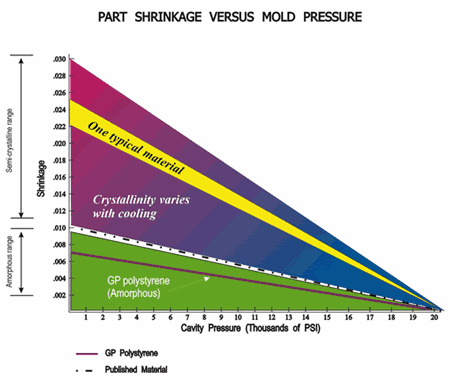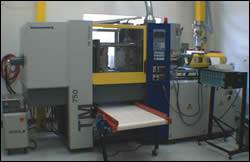Understanding the Effect of Pressure in the Cavity
Molders offer a moving target for moldmakers to adjust to by producing parts with different cavity pressures.
Have you ever adjusted the steel of a mold cavity, only to be told to return it back to its original dimensions? Has a customer ever requested adjustments to a mold and then claimed the adjustments must be wrong? Have you ever built a mold that produced parts that met all the requirements in your machine, but when the mold was run in the customer’s machine the dimensions were out of tolerance? Which machine should you adjust to?
Learning the Hard Way
Early in my career I received a good education from a bad problem that occurred with an outside tooling source. I had a vendor build an eight-cavity mold to replace an existing mold. The new mold was sitting in the tool room waiting for a tryout, (which we had failed to do in a timely manner, because we were too busy). One morning the old mold broke and of course we were behind in production, so it was agreed that we would install the new mold and start running production. The parts from the new mold were too small, under spec for the dimensions. I called the tooling vendor and explained to him that he had missed the dimensions on the print. He politely said “send it back with some parts and we will make the needed adjustments.” I put the mold on a pallet and shipped it the next day. We managed to find an old insert that made OK parts, though we knew we would need to inspect them before we sent them out. This would get us by until we got our new mold back. Two days later, the old mold broke again, this time the insert retainer plate. I called the tooling vendor to explain my dilemma and was told he was not in. I managed to talk to his shop foreman about what had happened and he said that he thought it was done because it was back on the pallet and the boss would not be back until the next day. I asked him to send it to us by next day air and we would pay for the freight. The next morning the mold setter installed the mold in a different machine of similar size and started molding parts that were now too big! Being very upset that the dimensions were now off again, I called the tool vendor and started expressing my dismay, when he stopped me and said he owed me an apology. Then he explained that they had not touched the mold.
Lesson Learned
This was a turning point in my career. I clearly did not understand what impacted the dimensional change that was being influenced by either the molding machine or the process that we built. Even when we used the exact machine setup numbers we could not make the same parts.
This situation has probably caused more arguments between molders and mold builders than any other single cause. The only way to avoid this mistake is for both parties to fully understand the impact pressure has to the shrink rate that is applied to the cavity. When more pressure is applied to the cavity, more plastic is pushed inside the cavity; therefore, decreasing the space between the molecular chains, allowing less room for shrinkage to take place. This will cause the dimensions to become larger and the toolmaker will miss his target.
It is important to find the correct pressure in the cavity that meets all or nearly all dimensions. Then note these measurements from inside the cavity or minimally from the molding machine so that every time the molder does a tryout or a production run it repeats the in-cavity pressure conditions (one of the four plastic variables).
Examples
To better understand how this affects dimensions; observe the graphical interpretation of a simple part shown in Figure 1. First, plastic is compressible ½ to 1 percent per 1000 psi. (½% amorphous, ¾% semi-crystalline, 1 percent heavy crystalline) Second, viscosity changes with injection speed (slower typically is higher, faster is lower) and most materials also exhibit a plus or minus 10 percent viscosity shift. These items can cause great problems in maintaining dimensions and this does not include out-of-control regrind, which makes the viscosity change even greater.
When viscosity changes, it will affect the pressure loss across the cavity at a 1:1 ratio. For example, the pressure loss on the part in Figure 2 is 10,000. If the viscosity is shifted by 10 percent (higher) the pressure loss changes to 11,000ppsi across the part. Subtract 11,000 from 12,000 (post gate pressure) and you are left with 1,000ppsi at the end of cavity. For a high crystalline material the compressibility is 1 percent per 1000 psi. This same 1 percent also influences the dimensions at that point in the cavity. Therefore our post dimension of .500 would change to .495, which would be out of print.
Let’s take one more look at a higher viscosity material, or a very slow injection speed, that results in a viscosity change of 20 percent. The pressure loss of 10,000 would then change to 12,000. Twelve thousand new pressure loss subtracted from the post gate pressure of 12,000 gives a 0 cavity pressure at the end of cavity or a short shot. In these examples, when viscosity goes up, pressure loss becomes greater. Materials with very high melt flows (100 MFI for example) are less affected by this because this would be typically a short chain material.
Solution
A mold must have a tryout where pressure in the cavity is identified and correlated to what pressure produces a good part. This must be repeated during every sample run until all adjustments are completed; otherwise the molder is offering a moving target for the moldmaker to adjust to, by producing parts with different cavity pressures. Peak pressure at transfer does give us an inclination of the pressure requirement to produce a good part, although it does not do a good job of telling us what is going on inside the cavity due to viscosity changes.
In summary, it is unwise to change steel dimensions of molds before the production process has been established and well documented, especially in regards to in-cavity plastic pressure. Plastic material, due to its very molecular structure, is subject to large pressure losses throughout the mold. While dimensional requirements of the individual parts will dictate what degree of control is necessary (whether matching machine pressures is good enough, or if in-cavity pressure sensing is needed), steps must be taken during mold and process development to repeat in-cavity pressures in-spite of changing plastic viscosities.
Of course pressure is not the only variable in molding plastic parts. Other items that must be considered when adjusting mold dimensions are plastic flow rate (i.e., cavity fill time) plastic cooling rate and time, and melt temperature. It is important to repeat all of these plastic variables with the least amount of variation. In most cases; however, the plastic pressure inside the mold cavities will have the single largest effect on part size.
Related Content
Laser Welding Versus Micro Welding
The latest battle in finely detailed restoration/repair of mold materials.
Read MoreThe Ins and Outs of Hot Runner Temperature Control
A training checklist that explains the why and how of proper hot runner temperature control and system management.
Read MoreIt Starts With the Part: A Plastic Part Checklist Ensures Good Mold Design
All successful mold build projects start with examining the part to be molded to ensure it is moldable and will meet the customers' production objectives.
Read MoreLine Width vs. Depth Ratio in Laser Engraving
A laser does not produce 90-degree sidewalls. It requires a certain amount of draft in order to produce the required pattern.
Read MoreRead Next
Rigorous Mold Tryout: Do Your Homework
If moldmakers strive to understand how an end user will use the mold, they will help their customers become more profitable and more confident in the shop’s abilities leading to a strong partnership.
Read MoreHow to Use Continuing Education to Remain Competitive in Moldmaking
Continued training helps moldmakers make tooling decisions and properly use the latest cutting tool to efficiently machine high-quality molds.
Read MoreAre You a Moldmaker Considering 3D Printing? Consider the 3D Printing Workshop at NPE2024
Presentations will cover 3D printing for mold tooling, material innovation, product development, bridge production and full-scale, high-volume additive manufacturing.
Read More


















